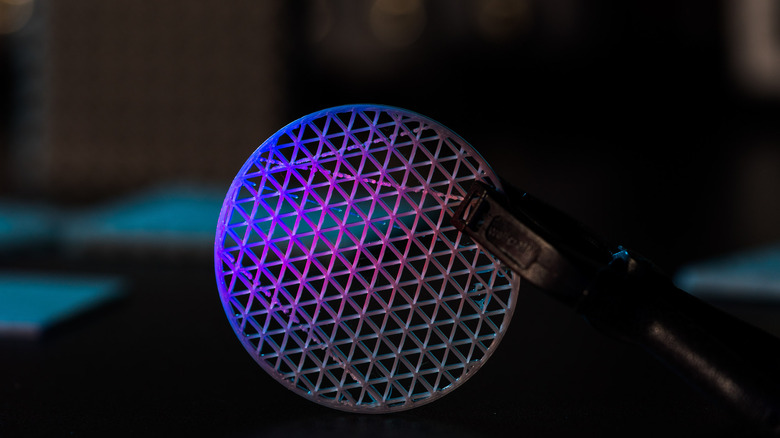Here's How A Real Life Invisibility Cloak Actually Works
Both the Romulans and Klingons use cloaking technology to strike at starships belonging to the United Federation of Planets. The Predator routinely uses cloaking tech to take out its prey. And Harry Potter got his Cloak of Invisibility as a Christmas present. Flights of science and fantasy, to be sure, but invisibility is no longer relegated solely to the imagination. Cloaking technology is real, albeit still in a primitive form when compared to the examples above. Yet, scientists are feverishly progressing to the point where you can throw on a piece of clothing... and vanish into thin air.
Since the early 2000s, optical camouflage has been a thing, but the process was so laborious that it was rendered all but useless. It required someone to stand stoically in one spot wearing what looked like a rain poncho covered with a highly reflective material. Directly behind that person was a digital video camera recording images fed into a computer and made to look as realistic as possible. The computer sent these enhanced images to a projector in front of the person, which shone them into a unique mirror called a combiner, bouncing the background images onto the cloak like a movie screen (via HowStuffWorks). Somehow all this was supposed to make the poncho-clad person look "invisible." It did not.
But it was a starting point, and technology and science have evolved over the last 20 years.
Your eyes can play tricks on you
Two things happen when light (from any wavelength) is shined on an object: The object reflects and bounces the light back to your eyes, making it visible, or it absorbs the light and shrouds the thing but leaves a shadow. In either case, the object doesn't appear to be transparent. The goal of cloaking technology is to bend light around an object so that anyone looking at it from any direction or angle will only see what's behind it, effectively rendering it transparent and invisible to the eye.
Hyperstealth Biotechnology Corporation is a company based in Canada known for providing a wide assortment of camouflage gear to armies worldwide. In October 2019, it filed four patents associated with a new material called "Quantum Stealth." This cheap, flexible metamaterial not only bends light around a target in the visible spectrum but also bends ultraviolet, infrared, and shortwave infrared light while simultaneously blocking the object's (or person's) thermal signature and its shadow. Moreover, this broadband cloaking technology doesn't need a power source and can work "in any environment, in any season at any time of the day or night."
The thin metamaterial is made from a slightly offset pair of lenticular lenses, causing a "Negative Refractive Index." It's the use of back-to-back lenticular lenses that creates the effect. Using only one would simply blur the background image and fool no one. A lenticular lens is basically a ridged sheet made up of rows of convex (outward-curving) lenses. Quantum Stealth "magically" bends the light and shows background details but also creates a "dead spot" directly behind the material for an object to hide, leaving people blind to the illusion.
Metamaterials and metalens and nanotech, oh my!
While Quantum Stealth has plenty of advantages, it has its limitations too. Mainly, it still uses a lens — lenticular or otherwise — and is thus susceptible to chromatic aberration, also seen as a colorful rainbow effect. Different wavelengths travel at different speeds (blue travels slower than red light). Secondly, it's not a fabric that can be made into something you put on and walk out the door wearing, like a cloak.
But using metalens, a nanoscale optical device, might allow something to be worn easily. Theoretically, a metalens can bend light from any wavelength and focus it down to an infinitesimally small point. In 2018, a team led by Wei Ting Chen showed that they could "tune the speed of light" by using metalens fitted with a pair of titanium-based nanofins. The team could nearly cover the entire visible-light spectrum from 470 to 670 nm by guiding and bending visible light precisely into one focused spot. Human vision is between 400 to 700 nm (via Big Think).
It's highly possible that in some clandestine lab, a prototype exists that has combined metamaterials with these nanotech metalenses. The military will probably get it first, and it might be rolled out to the public eventually. However, the morality behind becoming invisible is up for debate (and worthy of its own discretion). But, should an invisibility cloak hit the racks at your local retail shop, let's hope it looks a little chicer than Harry Potter's.

